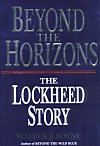Not
long after the Electra entered service, there were three crashes, two
of which involved wing separation (the other was attributed to pilot
error). As a result, performance restrictions were imposed and Lockheed
instigated a modification program which came to be known as LEAP. Several
references decode the acronym as "Lockheed Electra Achievement
Program" but Lockheed sources state that the correct title
is "Lockheed Electra Action Program".
The following account of LEAP is extracted from Beyond the Horizons
- The Lockheed Story by Walter J. Boyne (St. Martin's Press, New
York 1998):
 |
Investigation
revealed that under certain conditions of engine nacelle or power-plant
damage, a phenomenon known as 'whirl mode' could occur. 'Whirl
mode' refers to the results of the application of a force to gyroscopic
characteristics of a rotating propeller. When such a force is
applied, precession occurs; that is, like a gyroscope, the propeller
reacts ninety degrees out of phase to the applied force. This
causes the structural resistance of the engine mounting system
to apply a nose-down pitching moment. This forces the propeller
disc (as viewed from the rear) to turn to the left due to precession.
This in turn causes a nose-down propeller disc yawing to the right,
which causes a nose-up pitch, completing the cycle. This combination
of effects is termed the 'whirl mode', and its direction of rotation
is opposite to that of the propeller.
In a normal aircraft, the whirl mode could operate only within
the limits of the flexibility of the engine mounts. If, however,
some structural element of the power plant, the power-plant mounting
system, or the nacelle was in a damaged or weakened condition,
the whirl mode would not damp out, but could become more violent,
increasing damage to the structure, and could approach the natural
frequency of the wing. This would perpetuate the whirl mode in
a form of induced flutter and lead to catastrophic failure.
John Margwarth, another University of Michigan man, was director
of safety for Lockheed, and it was his insight that led to an
investigation revealing that the Electra's fatal flaw was in the
three member structure connecting the gearbox and the engine,
a part supplied by the engine manufacturers. When one member of
that structure failed, the engine mount became flexible. On an
outboard engine, at the Electra's original cruise speed, failure
of the strut induced immediate, violent flutter that tore the
wing off.
Technically, Lockheed could have passed the problem off to the
engine manufacturer, disclaiming responsibility. Instead, it redesigned
the wing structure so that it would not flutter when such a failure
occurred. (Allison also redesigned the strut so that it would
not fail.) Additional mounts were added to stabilize the propeller
in the event that any mount failed, or if breakage occurred between
the gearbox and the power section. The nacelle structure was also
strengthened by the addition of reinforcements and diagonal braces.
Lockheed was rocked by the three crashes and their adverse publicity.
For weeks there was one meeting after another to handle the latest
problem. It was soon evident that engineering the wing modification
was not going to be as difficult as finding a way to pay for it.
Carl Kotchian recalled coming out of a meeting with Robert Gross,
the latter sunk deep in thought. (Gross had been under considerable
strain for some time; he would die less than two years later.)
In the garage, Gross asked, 'How much do you think the modification
is going to cost?' Kotchian hesitated and said, 'Well, I think
it's going to cost maybe $25 million.' Gross turned white, then
replied, 'Well, we've got to do it.'
And Lockheed did, instituting the Lockheed Electra Action Program
(LEAP) and modifying all Electras at its own expense, whether
they were within warranty or not. The LEAP program came in just
under Kotchian's $25 million estimate. |
|

